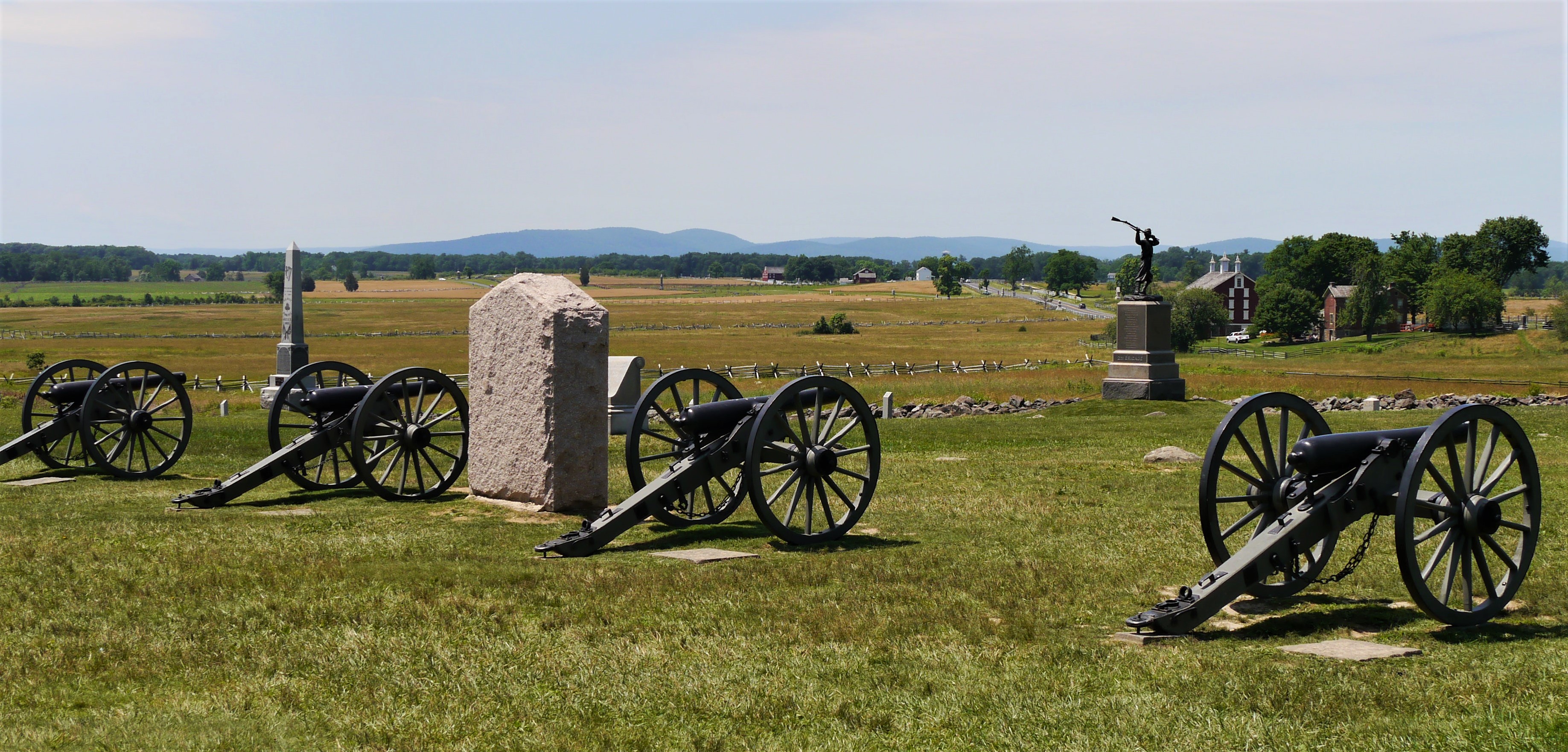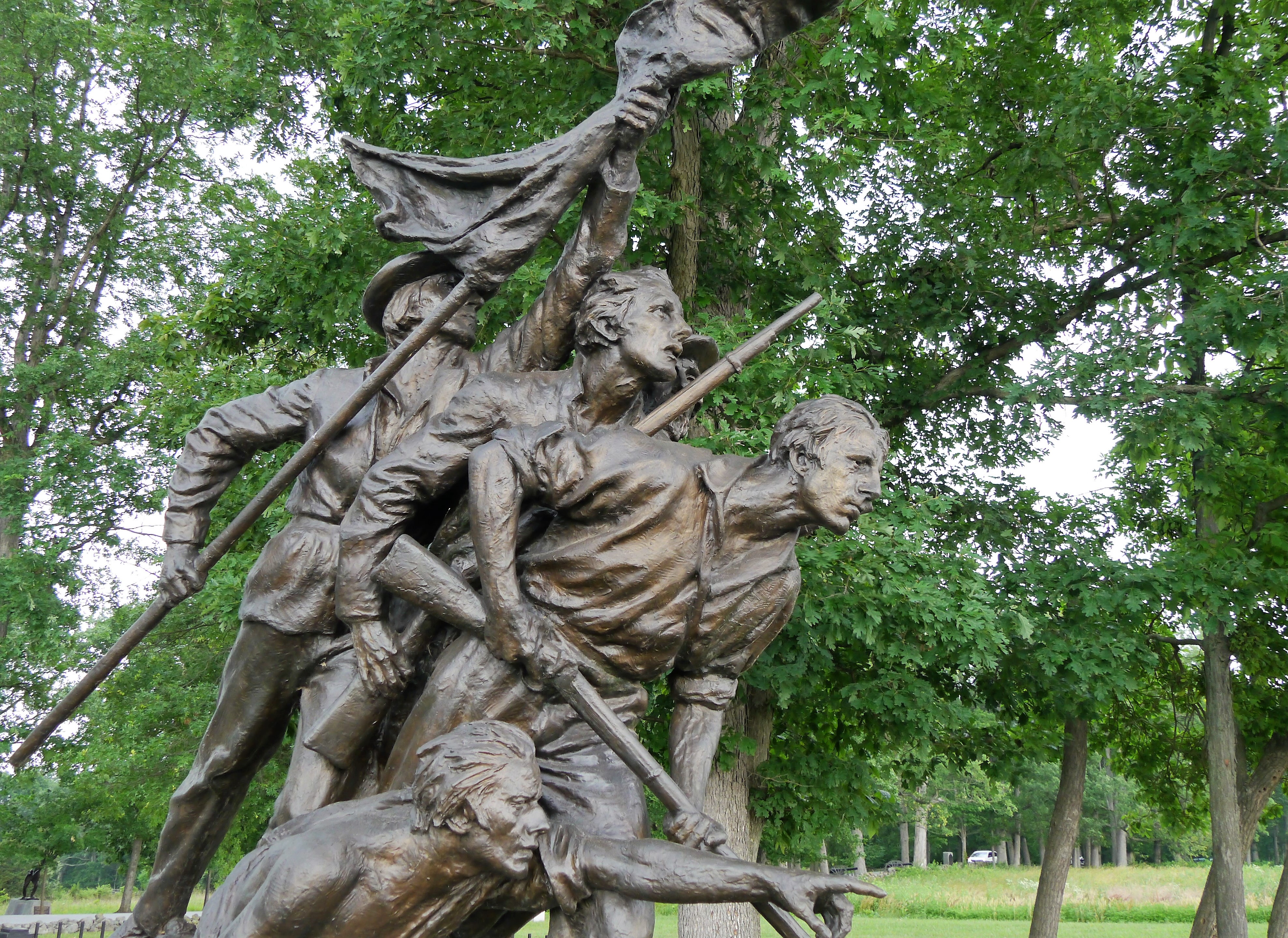
We travelled north through the beautiful Maryland countryside and broke across the Pennsylvania border in a very different manner than General Lee’s army did a 150 years before. The year, 1863, it is hot and muggy approaching the month of July. The American Civil War is raging, battle casualties range in the tens of thousands in a day or two–the war is a test of wills between state rights to secede, versus federal authority to maintain the union–and the war is far from over.
Lee’s idea is to build on the South’s recent successful battles and strike hard into the north, destroying the Army of the Potomac, then attack Philadelphia, Baltimore, or even Washington D.C. Such a blow will further demoralize a war weary north into a negotiated peace–allowing the South to become a new nation, to maintain and expand its valued slave population and its way of life. This goal is a very likely outcome if Lee and his army are successful. Using the Blue Ridge Mountains to screen his advance of 70,000 plus men, and a handful of women disguised as men, he races northward as fast as marching soldiers in murderous heat can. They are in high spirits, feeling that their general has a golden touch; a subtle but real collective energy Napoleon called moral force; a confidence, or what today in sports might be called momentum or being on a winning streak.
A Federal cavalry unit spots Lee’s advance men and sets up a line of defense just north of the small hamlet of Gettysburg; a hub with spokes of ten roads spreading out in all directions making this a vital strategic spot. It is to be a three day battle that has the highest casualty rates of the war, over 50,000, of an already deadly war–the stakes cannot be higher. Three days earlier Lincoln relieved the commanding general of the Army of the Potomac for incompetence, and places a reluctant General Meade at its head. The North has been pummeled in several battles and the spirit of the soldiers has suffered. Nevertheless they rush in great numbers to meet the newly arrived Confederates–a tremendous battle ensues. Though not unanticipated by Lee, neither side could have planned for the battle to occur precisely at this time, or in this place.
General Meade is the right man; he proves it time and again by making correct decisions–from the formations of his corps in a fishhook appearance that stretched Lee’s army, to the speed of Federal troops responding to the fluid conditions that occur in any battle. A brand new General Meade out-generalled the leading general of the South, and Gettysburg sends the Army of Northern Virginia back home with tremendous losses of men and supplies; both of which it cannot easily replace. This is a change in the fortune for the North and a pivot point in the War; Gettysburg coincides with a brilliant victory by another Northern general, U.S. Grant, with the taking of Vicksburg and the surrender of a Confederate army of 30,000 soldiers on the fourth of July.
We arrive at Gettysburg, which is now a National Park. Its peaceful countryside betrays nothing of the three day battle that explodes with 160,000 troops over these fields 150 years ago. President Lincoln, a great soul in God, is convinced, as many of the founding fathers were, that this United States republic is an experiment that will be a model for governments around the globe in years to come. Its ability to survive the election of a president that did not win a majority of votes and that half the country deeply mistrustes is essential to this vision. It must continue in order to lead the way, not only for itself, but for the good of the world. It is divine Providence that Lincoln feels is at work here, and the union must stay united–not be fractured into smaller nation-states. This raises the stakes beyond the moment of simple politics, power, or force; it makes it a spiritual mission that supersedes the lives of individuals, including the president himself. Although Lincoln abhorres slavery, it was not his intention when he took office to do away with it, rather for the sake of the maintaining the union it would continue to exist in southern states; hopefully one day to die out due to its inherent inefficiency. It is only when the great cost of lives and resources mountes in the war that he resolves that slavery will not continue. This is celebrated by some, and decried by many others in the north for various reasons. However, the stage is being set for the repugnant stain of owning a human being to be abolished forever.
We spend a full day touring the vast field of battle, larger than what you can see from any one vantage point. We have an excellent tour by a retired career military officer who had taught military strategy as well as being involved in the NASA program; he is eminently qualified to talk about this battle. He also spent years walking these fields, imagining the foot soldier enduring the noise, confusion, fear, pain and exhilaration of battle. He wants us to immerse ourselves as well, not as casual visitors, but as far as possible to be a participants of those events. He relates personal stories, speaks of the terrific sounds that haunted men’s lives forty years after the battle. Imagine the sights and smells as the battle rages all around: sulphurous smoke stinging and blinding the eyes, cannon shell exploding overhead with fragments zinging all around, mini bullets sounding like angry bees zipping by, comrades dropping, screams of agony, pushing forward or defending against an onslaught, calm minds focused on the business at hand, panic filling another’s eyes, standing shoulder to shoulder, officers calling out commands, not knowing what is going on, who is winning or losing, when will help arrive, rumors mostly wrong spreading like wildfire, the fog and confusion of battle all around, “Will I go home? Will that be my amputated limb left on a pile stacked like cordwood? Will I be brave or will I run?”
In the midst of this time of battle there are extraordinary acts of courage and compassion. As the first day of battle is engaged, a caring officer helps a mother and two young children move from their home, that happens to be in the middle of this quickly evolving battlefield. Exhausted, with too few men to defend the army’s left flank on Little Top hill, an officer and all his soldiers are out of ammunition–he leads his men in a frontal bayonet charge that carries the field. Countless heroes on both sides. A desperate battle that can hinge on the seemingly smallest of factors that decides who will win and who will die. It is a tour and a day to remember.
After this guided tour on the field we move through the museum, and then follow a CD voice tour (Bruce and Janice have loaned us) as we drive from site to site following the historian’s description of the action where the battles actually ensued. It was all interesting, engaging, and exhausting. Not exhausting just because of the physical demands of the day, but emotionally and spiritually engaging with the horrors and sufferings, the heroism and selfless sacrifice that are, to this day, poignant beyond words. It is a feeling that continues to cling to us.
As President Lincoln said a year and a half later in his second inaugural address (below), describing the karmic consequence of slavery by a nation that allowed it, even embraced it in contradiction to its own Declaration: that All men are created equal. Obviously all men are not created of equal physical strength, intelligence or moral fiber. However, all humankind is equal in the sight of God, all deserve respect, dignity and the unalienable Rights of life, liberty and the pursuit of happiness. Lincoln said:
“Fondly do we hope, fervently do we pray, that this mighty scourge of war may speedily pass away. Yet, if God wills that it continue until all the wealth piled by the bondsman’s two hundred and fifty years of unrequited toil shall be sunk, and until every drop of blood drawn with the lash shall be paid by another drawn with the sword, as was said three thousand years ago, so still it must be said ‘the judgments of the Lord are true and righteous altogether.’”
The day after this experiential tour of the battlefield we had a very different kind of experience. Previously, when driving north through Maryland we saw signage that alerted us to the fact that Emmitsburg had been home to a Catholic saint–the first canonized American. In anticipation we were thrilled to think of having the darshan of the Samadhi Basilica of this first recognized Catholic saint of America–but the description of our time with her will have to wait for another posting….
